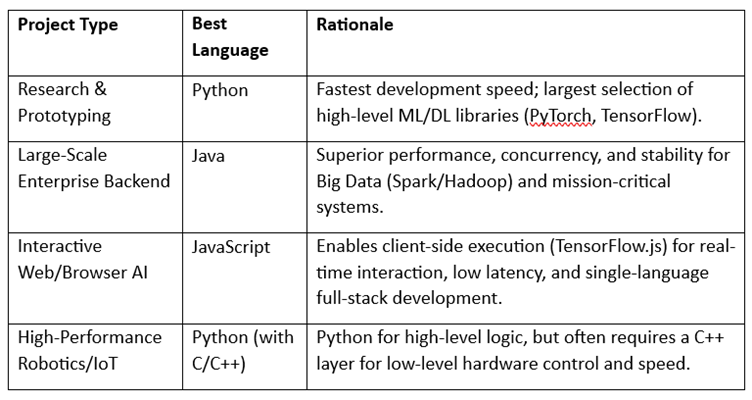|
Voiced by Amazon Polly |
The AI Developer's Dilemma: Choosing the Right Programming Language
In the world of Artificial Intelligence and Machine Learning, the programming language you choose is more than just syntax; it’s an ecosystem that defines your project’s development speed, scalability and deployment environment. While new and specialized languages like Julia and R have their niches, three heavyweights from the general programming world continue to dominate the discussion: Python, Java and JavaScript.
So, which language or framework is “better” for your next AI endeavor?
It depends entirely on the phase of your project and its final destination. Are you building a research prototype, an enterprise-grade backend service or a real-time, browser-based application? Each language excels in a different arena.
Let’s dive into the strengths and weaknesses of each language, breaking down the debate into core categories like Ecosystem, Performance and Application Focus.
Freedom Month Sale — Upgrade Your Skills, Save Big!
- Up to 80% OFF AWS Courses
- Up to 30% OFF Microsoft Certs
- Ends August 31
Python- The Reigning Champion of ML/AI Research
Python’s dominance in the AI landscape is nearly undisputed, especially in the initial research, prototyping and experimentation phases. Its clean, English-like syntax and emphasis on readability have made it the language of choice for data scientists and researchers worldwide.
The Python Advantage: Ecosystem and Simplicity
The single greatest asset Python brings to the table is its unrivaled ecosystem of libraries. These libraries provide high-level abstractions, allowing developers to focus on the model’s logic rather than low-level implementation details.
Core Libraries:
- NumPy and Pandas for efficient numerical operations and data manipulation.
- SciPy for scientific and technical computing.
Deep Learning Powerhouses:
- TensorFlow (backed by Google) and PyTorch (backed by Meta/Facebook) are the industry standards for building, training and deploying sophisticated neural networks. These are often written in highly optimized C++ for speed, but are accessed almost exclusively through their beginner-friendly Python APIs.
- Scikit-learn for traditional Machine Learning algorithms (classification, regression, clustering).
Python’s rapid prototyping capability is crucial. Its dynamic typing and interpreter-based nature allow developers to iterate quickly, test hypotheses and move from concept to model in a fraction of the time it would take in a more verbose, statically typed language.
Java- The Enterprise Workhorse and Scalability King
While Python owns the research lab, Java is the undisputed champion of the enterprise-grade, mission-critical backend. When your AI model needs to integrate seamlessly into a massive, globally distributed system- think banking, insurance or telecommunications- Java shines.
The Java Advantage: Robustness and Performance
Java’s key strengths are its scalability, performance and stability, all stemming from the mature Java Virtual Machine (JVM).
- True Scalability: Java‘s strong static typing and object-oriented principles promote code clarity and make large, long-term AI systems more maintainable. It’s mature multithreading capabilities are essential for handling high-throughput, real-time data processing required for applications like fraud detection or recommendation engines at scale.
- Enterprise Integration: Most major Big Data frameworks, like Apache Hadoop and Apache Spark’s MLlib, are built on the JVM. Integrating an AI component into an existing enterprise data pipeline is often simpler with Java. Libraries like Deeplearning4j (DL4J), Weka, and Tribuo are production-focused alternatives to the Python stack, trusted for their reliability in corporate environments.
Java is the choice for deployment where stability, speed and existing infrastructure alignment are the top priorities.
JavaScript- The Ubiquitous Frontend AI
If Python is for the research lab and Java is for the enterprise server room, JavaScript is for the web browser and the edge device. Born as the language of the internet, JavaScript (and Node.js) is transforming AI deployment by bringing intelligence directly to the user’s device.
The JavaScript Advantage: Universal Reach and Real-Time Interaction
JavaScript is the most widely adopted language in the world, and its AI story revolves around client-side execution and interactive AI experiences.
- Browser ML: Libraries like js and ml5.js allow trained models (often originally built in Python) to run directly in the user’s browser or on a Node.js server. This provides two major benefits:
- Low Latency: Inference (running the model) happens instantly on the user’s device, without needing a round trip to a server. This is perfect for real-time computer vision or interactive chatbots.
- Data Privacy: User data stays local, improving privacy and reducing the burden on the backend server.
- Full-Stack AI: With Node.js, JavaScript developers can build the entire application- model training, backend API and frontend user interface- using a single language and talent pool, streamlining the development process for modern web applications.
JavaScript is the ideal choice for developers whose final product is a highly interactive web application that requires low-latency, real-time AI features.
The Project-Based Verdict: Choosing the Right Tool

Comparison table showing the best programming languages for different AI project types and their rationale.
The AI Polyglot Advantage
When facing the AI developer’s dilemma, the most valuable developer is often a polyglot.
The reality of modern AI deployment is a multi-language pipeline:
- Research & Training (Python): Use Python for the speed, data science libraries and ease of experimentation to build and train the core model.
- Deployment (Java/Python): Deploy the trained model. If the application is a high-traffic enterprise service, a Java backend (using Spark or a robust framework) provides the necessary stability and performance. If it’s a lighter web service, a Python micro-framework like FastAPI can efficiently serve the model.
- User Experience (JavaScript): Use JavaScript to build the interactive front end, often integrating a compressed version of the model via js for real-time, personalized user experiences.
The question isn’t which language is better, but which one is best suited for the current phase of your project. Start with Python to prove your concept, leverage Java to scale to a billion users and utilize JavaScript to bring intelligence directly to the user’s screen.
Freedom Month Sale — Discounts That Set You Free!
- Up to 80% OFF AWS Courses
- Up to 30% OFF Microsoft Certs
- Ends August 31
About CloudThat
CloudThat is an award-winning company and the first in India to offer cloud training and consulting services worldwide. As a Microsoft Solutions Partner, AWS Advanced Tier Training Partner, and Google Cloud Platform Partner, CloudThat has empowered over 850,000 professionals through 600+ cloud certifications winning global recognition for its training excellence including 20 MCT Trainers in Microsoft’s Global Top 100 and an impressive 12 awards in the last 8 years. CloudThat specializes in Cloud Migration, Data Platforms, DevOps, IoT, and cutting-edge technologies like Gen AI & AI/ML. It has delivered over 500 consulting projects for 250+ organizations in 30+ countries as it continues to empower professionals and enterprises to thrive in the digital-first world.

WRITTEN BY Vishwas K Singh
Vishwas K Singh is a Subject Matter Expert - FSD, Cloud at CloudThat, specializing in Full Stack Domain. With 10+ years of experience in FSD, he has helped over 7000+ professionals/students to upskill in Backend, Frontend, Databases & Fullstack. Known for simplifying complex concepts, hands-on teaching and industry insights, he brings deep technical knowledge and practical application into every learning experience. Vishwas's passion for technology & teaching reflects in his unique approach to learning and development.


 Login
Login


 November 25, 2025
November 25, 2025 PREV
PREV











Comments